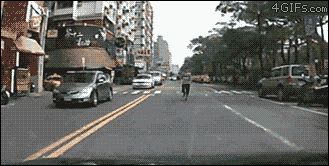In one study, the average driver saw dark-clothed pedestrians standing “a foot or two” to the right of the car at a range of 150 feet while 90% of the drivers fell in a range from 50-250 feet. When pedestrians stood to the left, the visibility distances halved. Using some reasonable assumptions, the authors concluded that a driver traveling 55 mph would fail to see a pedestrian on the right in time to avoid collision 45% of the time. If the pedestrian is standing to the left, the number grows to 95% - the driver will almost always hit the pedestrian.
Switching from dark clothing to a white vest markedly improved visibility. Drivers then detected pedestrians on the right at about 300 feet and pedestrians on the left at about 200 feet. Theoretically, the vest reduces the number of accidents to 3% right and 9% left, or an improvement by a factor of 10.
The benefit of lighter clothing is to be expected since detection depends on the amount of light reflected from the pedestrian back to the driver’s eye. This, in turn, is the amount of light falling on the pedestrian multiplied by reflectivity of the clothing. Pedestrians could be made more visible either by being more brightly illuminated by a closer headlamp or by wearing lighter, more reflective clothing.
At city driving speeds of 35 mph, the stopping distance is 138 feet and the stopping time is 3.6 seconds. These calculations also assume good conditions and ignore brake lag, the time from touching the pedal to full depression and lock up, which is likely .25-.50 sec. The requirements increase when the road is wet, the vehicle is heavier (a fully loaded tractor trailer can take 400 feet or more), the terrain slopes downhill or the driver’s reaction time is slowed.

 Home
Home
